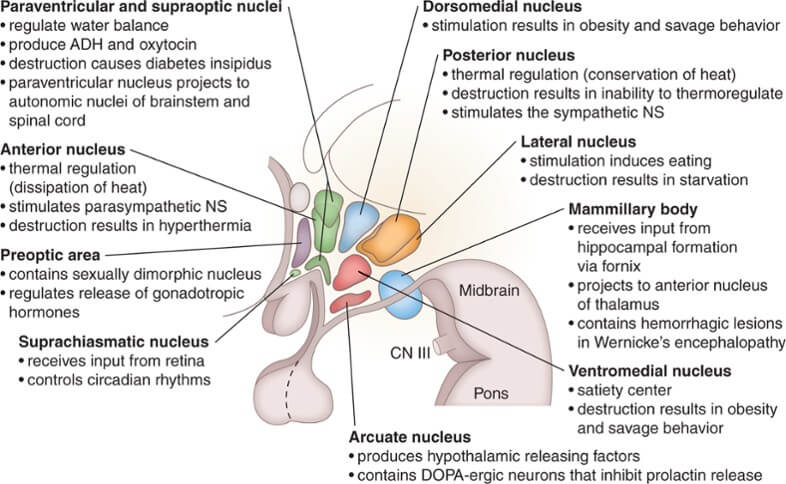
- Hypothalamus is composed of small nerve cells which are arranged in groups called hypothalamic nuclei.
- Many of these nuclei are not clearly demarcated from each other. Even some may show overlapping.
- A group of neurons, known as preoptic area, situated between lamina terminalis and optic chiasma, is anatomically part of telencephalon. But from functional point of view, the area forming a nucleus, reoptic nucleus is incorporated in hypothalamus (diencephalon).
- Various nuclei of hypothalamus are divided into three zones already stated. These zones are lateral, intermediate and paraventricular or subependymal. The last group is also known as medial zone.
- Some of the nuclei are bisected, thereby falling in two adjacent zones. These are – preoptic, supraoptic and tuberal nuclei.
- Nuclei which are anatomically classified, are not often grouped physiologically. It means that nuclei of two different anatomical zones may be physiologically identical in function.
- For more academic interest, very often, nuclei are classified in a complex manner. But simplest, conventional and mediolateral subdivision of nuclei of hypothalamus is mentioned below.
Lateral nucleus: This nucleus is made up of large sized and loosely packed neurons which occupies whole anteroposterior extent of lateral zone. Lateral nuclear zone is also associated with abundance of fibers.
Nuclei common for lateral and intermediate zones
- Preoptic nucleus
- Supraoptic nucleus
- Tuberoinfundibular nucleus
- Mammillary nucleus.
- Anterior nucleus
- Ventromedial nucleus
- Dorsomedial nucleus
- Posterior nucleus.
It is a thin strip-like zone just beneath the ependyma of lateral wall third ventricle at the level of hypothalamus. The nucleus is known as paraventricular nucleus. This nucleus is medialmost in position among all hypothalamic nuclei.
Source: Easy and Interesting Approach to Human Neuroanatomy (Clinically Oriented) (2014)